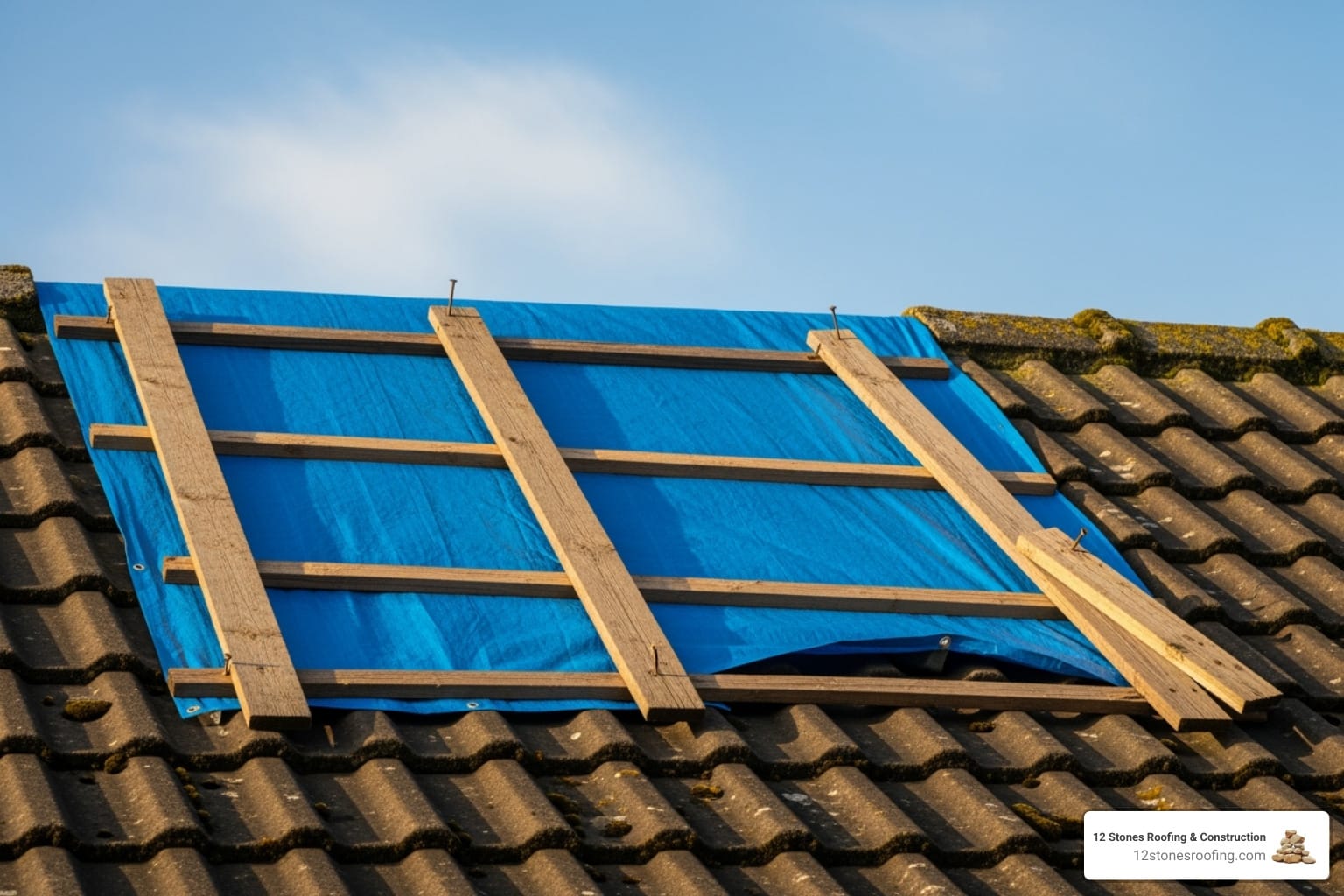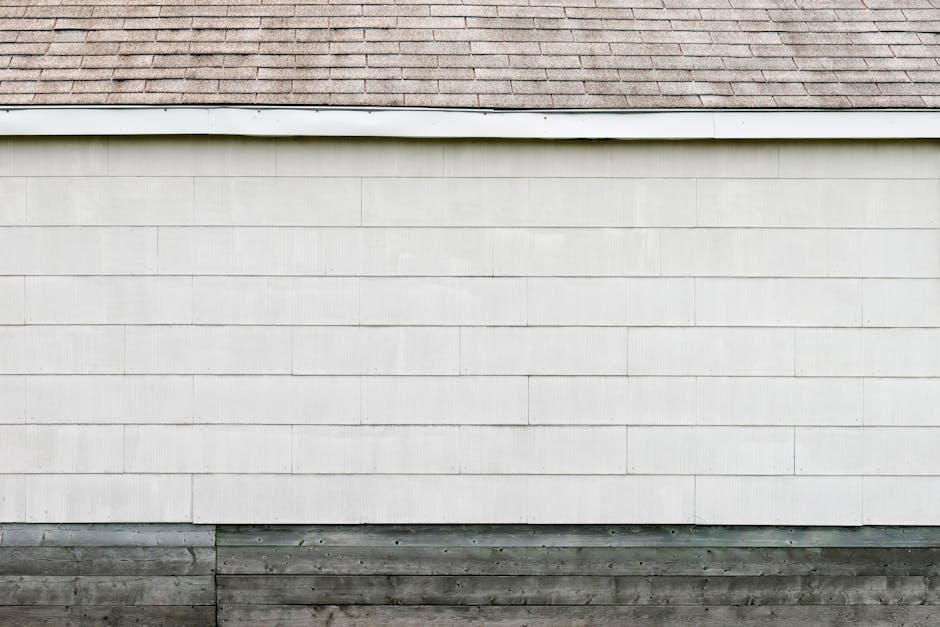New Flat Roof Installation: 20–30 Years of Watertight Protection and Lower Energy Costs
A new flat roof installation, delivered by a trusted Pasadena roofing contractor, provides 20–30 years of watertight performance, measurable cooling savings, and reliable storm resistance. The system’s success hinges on a precisely engineered, multi-layer assembly that forms a monolithic seal against Texas heat, UV, and sudden Gulf Coast storms. If your roof is over 10 years old and needs frequent fixes, a full replacement is the most cost-effective path to restore performance and warranty coverage for the long term.
Modern cool-roof membranes reduce heat transfer significantly; independent testing shows reflective roofs can keep surfaces up to 50°F cooler under peak sun, reducing HVAC strain in hot climates. Unlike sloped roofs, flat roofs depend on flawless detailing, drainage design, and seam integrity to remain leak-free for decades.
Key Steps for a Successful New Flat Roof Installation:
- Complete Tear-Off: Removal of all old roofing materials.
- Deck Inspection: Repair of any damaged substrate.
- Vapor Barrier: Installation to block internal moisture.
- Rigid Insulation: Placement for optimal energy efficiency.
- Membrane Attachment: Using fully adhered, mechanically attached, or ballasted methods.
- Seam & Flashing Detail: Welding and sealing all penetrations and edges.
- Drainage Integration: Ensuring proper slope to prevent ponding water.
- Final Inspection: A thorough quality assurance walkthrough.
As the owner of 12 Stones Roofing & Construction, I’ve overseen hundreds of flat roof projects across the Gulf Coast. My Service-Disabled Veteran-Owned firm specializes in TPO, EPDM, and modified bitumen systems, delivering installations ranked in the top 1% nationwide for quality.
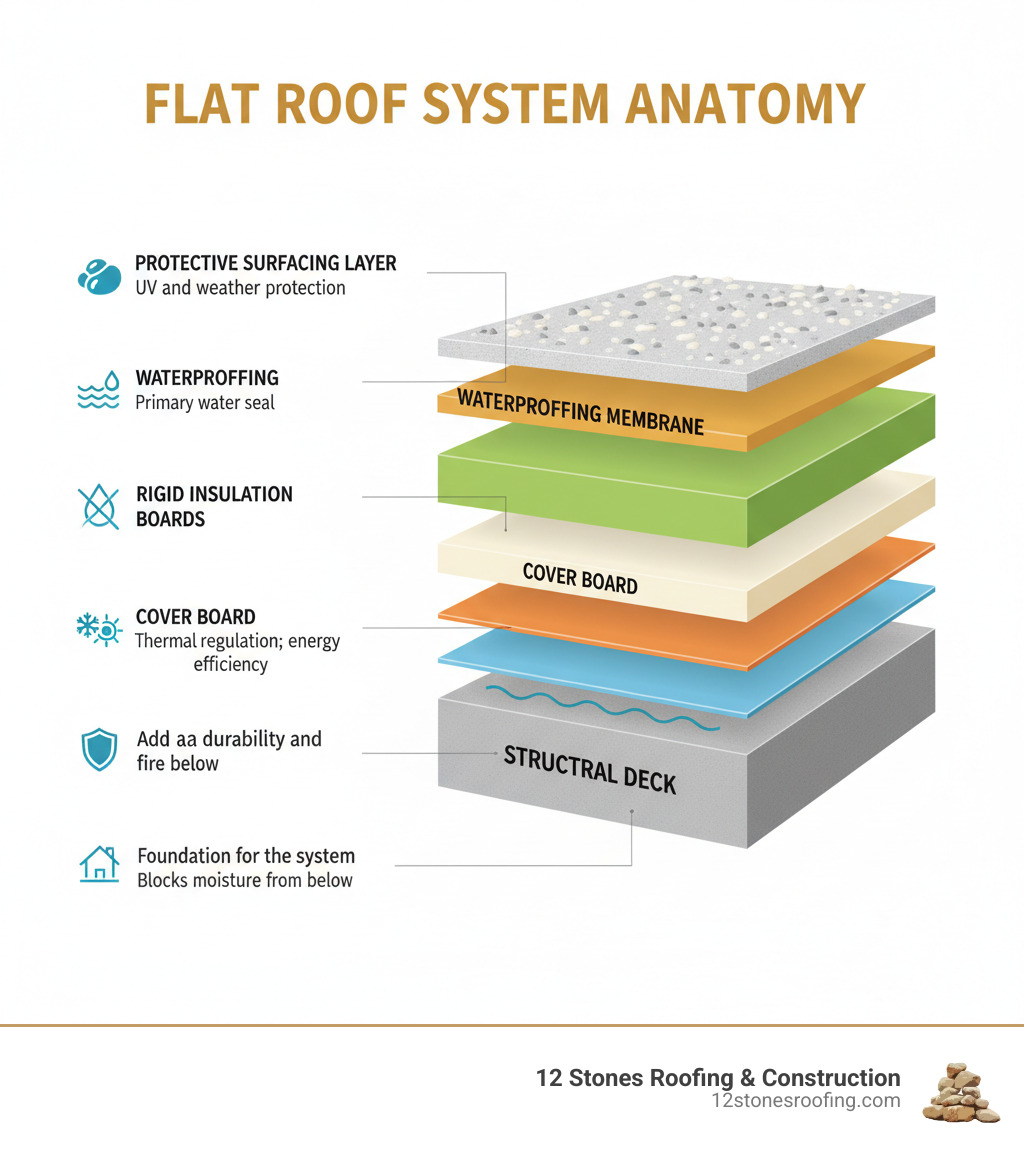
Plan Before You Build: Materials, Budget, and Why a Full Tear-Off Protects Your Warranty
A successful new flat roof installation begins with meticulous planning. This phase is about selecting the right materials, understanding costs, and making the non-negotiable decision to perform a full tear-off of the old roof.
Why Layering Over an Old Roof is a Costly Mistake
Property owners often ask about installing a new roof over an existing one to save money. While it sounds like a shortcut, this approach almost always backfires. A complete tear-off is the only professional standard, and here’s why it’s essential for protecting your investment:
- Structural Strain: Adding a second roof layer significantly increases the weight load on your building, potentially exceeding its engineered capacity and leading to sagging or structural failure.
- Trapped Moisture: Moisture caught between layers creates a breeding ground for mold, mildew, and rot, which silently degrades your roof deck and the new materials.
- Hidden Problems: Covering up damaged decking, saturated insulation, or other structural weaknesses doesn’t fix them. These issues will continue to fester, undermining your new roof from day one.
- Voided Warranties: Most leading manufacturers will not honor their roofing warranty if their system is installed over an existing roof, leaving you without protection against material defects.
- Code Violations: Many local building codes in the Pasadena, TX area prohibit more than two roofing layers. Layering can lead to fines and mandatory removal.
- Reduced Lifespan: A new roof’s performance is tied to its foundation. Installing it over a deteriorating system compromises its integrity and drastically shortens its expected lifespan, often requiring a premature roof replacement.
For a durable and efficient roof, a complete tear-off is the only way to proceed with a new flat roof installation. For more insights, resources like this article on why you shouldn’t layer a flat roof offer additional context.
Choosing Your System: A Comparison of Modern Flat Roofing Materials
The material you select is the most important factor in your roof’s performance and longevity. TPO currently leads the market with a 40% share of new construction, followed by EPDM at 22% and Modified Bitumen at 12.4%.
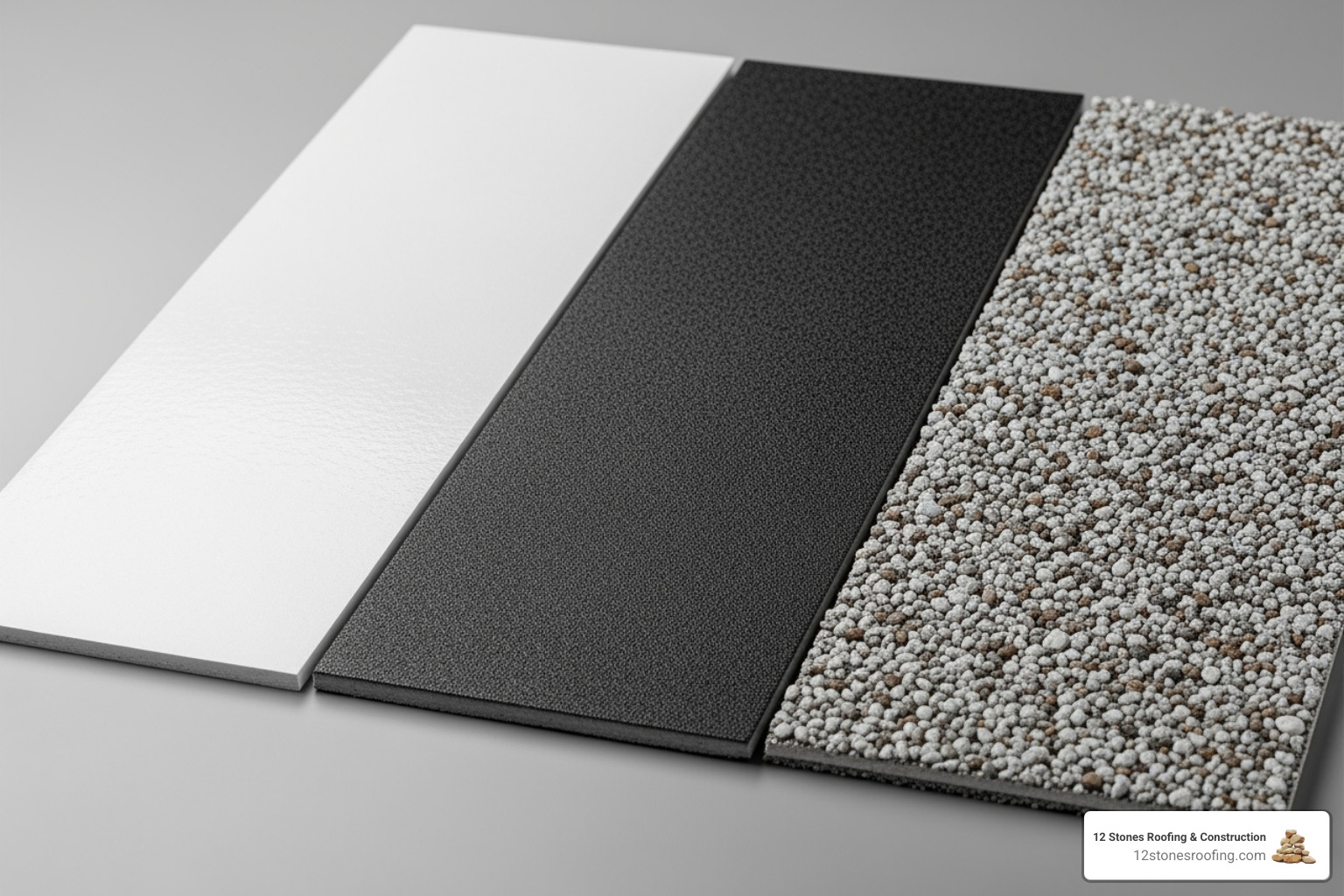
- TPO (Thermoplastic Polyolefin): This market-leading single-ply membrane features a reflective white surface that reduces cooling costs—a major benefit in Texas. Its heat-welded seams create a monolithic, watertight surface that is highly resistant to punctures.
- EPDM (Ethylene Propylene Diene Monomer): Often called “rubber roofing,” this durable synthetic rubber membrane is celebrated for its flexibility and resistance to weathering. It can be installed using various methods, making it adaptable to different buildings.
- Modified Bitumen: An evolution of asphalt roofing, this system consists of asphalt reinforced with fiberglass or polyester. It is known for its excellent waterproofing and durability, typically installed in two-ply systems.
- Built-Up Roofing (BUR): The traditional “tar and gravel” roof, BUR uses multiple layers of asphalt and reinforcing felts. While durable, it is heavier and more labor-intensive to install than modern single-ply systems.
Here’s a quick comparison of these top flat roofing materials:
| Material Type | Lifespan | Cost (New Const.) | Durability | Installation Method | Market Share (New Const.) |
|---|---|---|---|---|---|
| TPO Single-Ply | 20-30+ years | $6.90 – $11.20/sq ft | Excellent | Heat-welded seams, fully adhered or mechanically attached | 40% |
| EPDM Single-Ply | 25-35+ years | $4.50 – $8.50/sq ft | Excellent | Adhered, mechanically attached, or ballasted | 22% |
| Modified Bitumen | 20-25 years | $7.50 – $11.50/sq ft (2-ply) | Very Good | Torch-applied, hot-mopped, or self-adhered | 12.4% |
| Built-Up Roofing (BUR) | 20-30 years | $7.80 – $12.50/sq ft (4-ply) | Very Good | Hot-mopped asphalt and felt layers, gravel surfacing | Lower |
Budgeting for Your New Flat Roof Installation
Understanding the cost of your new flat roof installation is crucial. Prices vary based on material, roof size, complexity, insulation needs, and local labor rates. For property owners looking for roofing services in Pasadena, TX, here are typical price ranges per square foot for new construction:
- EPDM Single-Ply: $4.50 – $8.50 per square foot.
- TPO Single-Ply: $6.90 – $11.20 per square foot.
- 2-Ply Modified Bitumen (SBS): $7.50 – $11.50 per square foot.
- 4-Ply Built-Up Roofing (Asphalt & Gravel): $7.80 – $12.50 per square foot.
These are industry estimates; your project’s final cost may differ based on unique factors like the number of penetrations, drainage requirements, and accessibility. At 12 Stones Roofing & Construction, we provide detailed, no-obligation estimates custom to your project. Call us at (713) 358-8371 for a transparent and accurate quote.
The 7-Step Professional New Flat Roof Installation Process
A professional new flat roof installation follows a meticulous, multi-step process to create a watertight and long-lasting system. Each step is critical to the roof’s performance, especially under the demands of the Texas climate.
Step 1: Complete Tear-Off and Deck Inspection
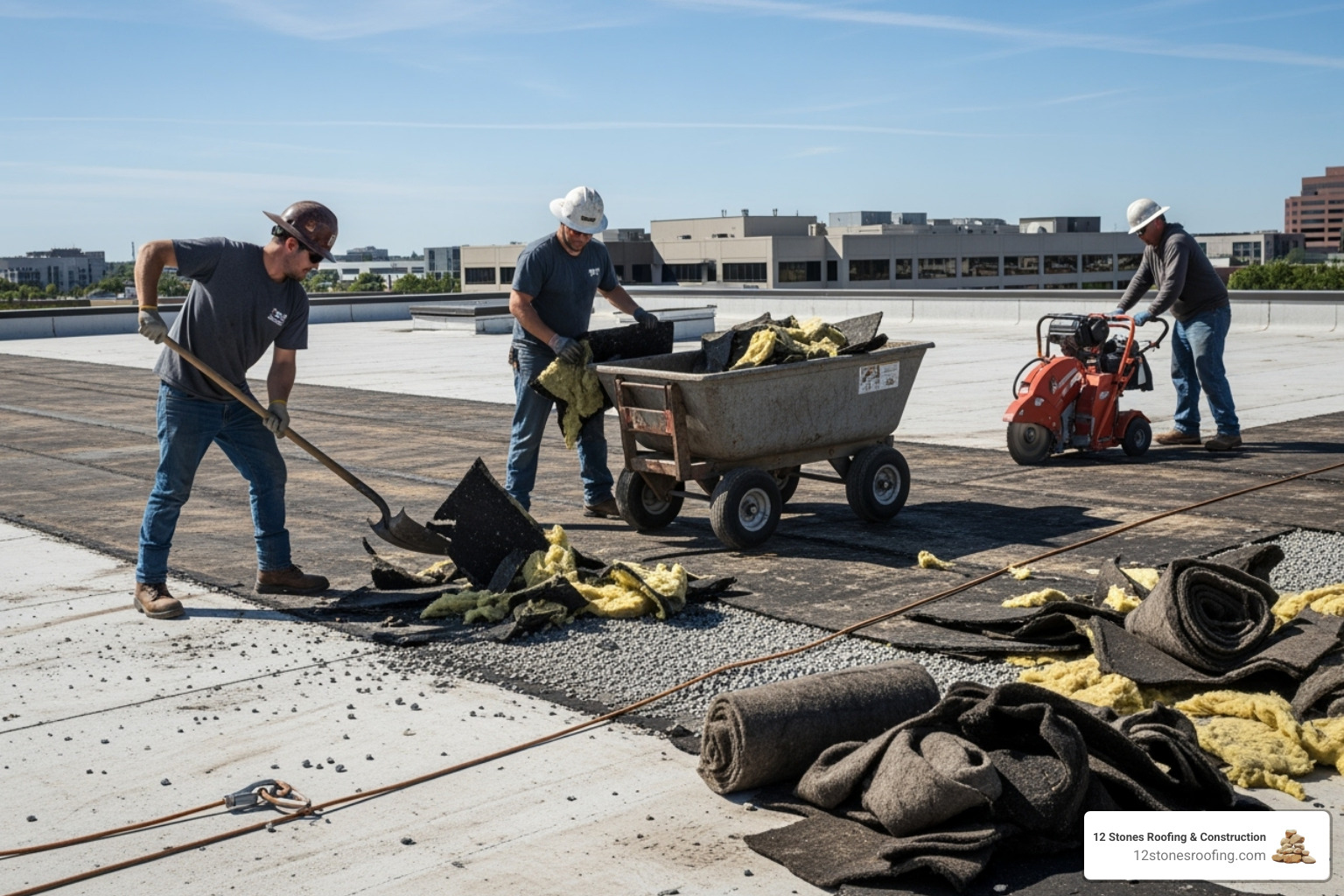
The process begins with a clean slate. We remove all existing roofing materials down to the structural deck. This complete tear-off allows our crew to perform a thorough inspection, identifying and replacing any sections of plywood or OSB compromised by rot, water damage, or structural weakness. This ensures the new roof is built on a solid foundation.
Step 2: Substrate Preparation and Vapor Barrier
With a sound deck confirmed, we prepare a clean, dry, and smooth substrate. Next, we install a vapor barrier directly over the prepared deck. This essential layer prevents moisture vapor from inside the building (from cooking, showers, etc.) from rising and condensing within the roof system, which would otherwise saturate the insulation and reduce its R-value.
Step 3: Installing Insulation (Warm vs. Cold Roof Design)
Insulation is vital for energy efficiency, especially for keeping your building cool during Texas summers. We use a “warm roof” design, the industry standard for modern flat roofs. In this setup, rigid insulation boards (typically Polyisocyanurate or “Polyiso”) are installed above the structural deck and below the waterproofing membrane. This keeps the entire roof structure warm, preventing condensation and optimizing thermal performance. We avoid “cold roof” designs, which can trap moisture and require complex ventilation.
Step 4: Attaching the Roofing Membrane
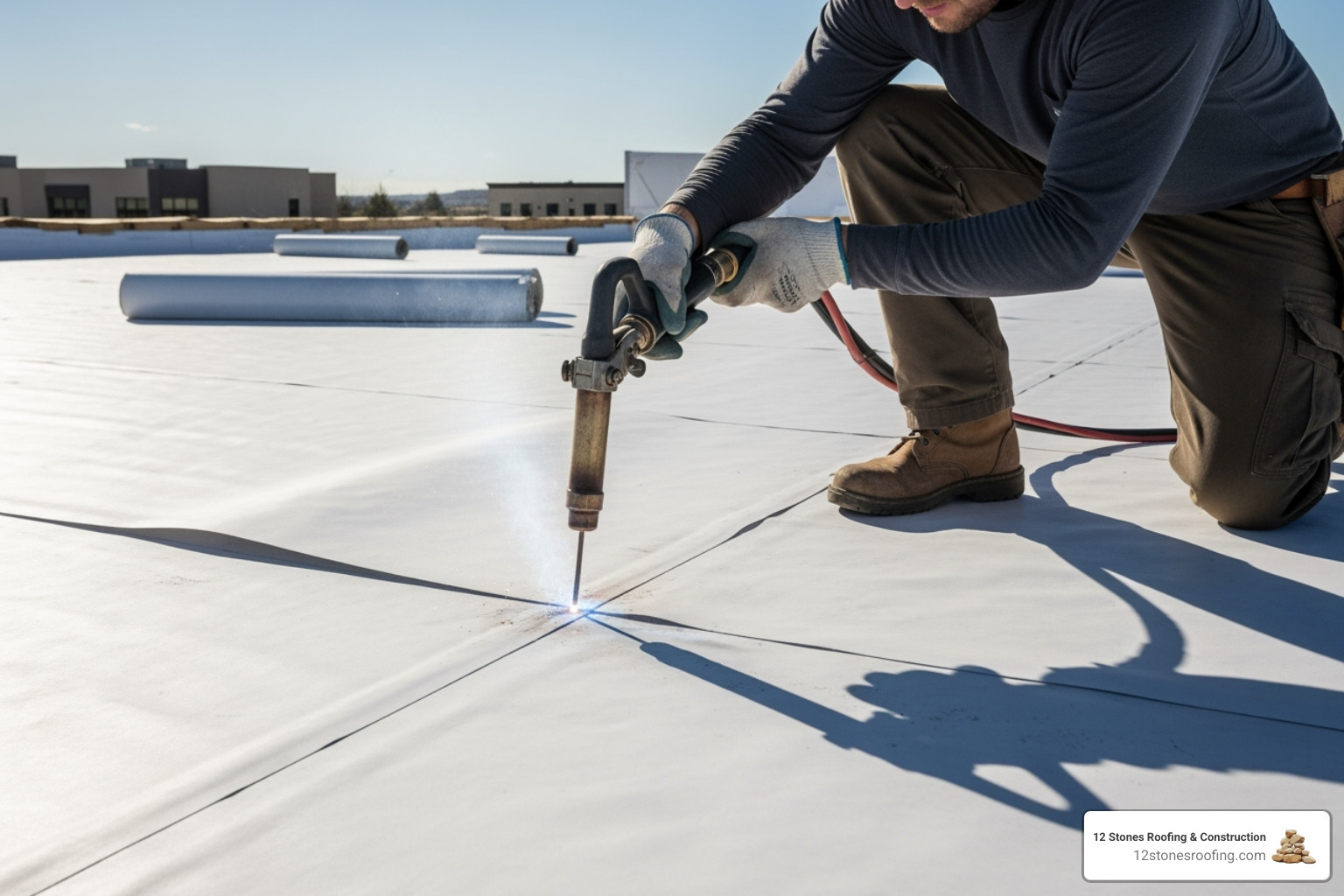
This is the primary waterproofing layer. The attachment method depends on the material and project needs:
- Fully Adhered: The membrane is glued to the substrate with a powerful bonding adhesive, creating a smooth look and excellent wind uplift resistance.
- Mechanically Attached: Plates and fasteners are driven through the insulation into the deck. This method is efficient for larger roofs.
- Ballasted: The membrane is laid loose and held in place with a heavy material like river rock or concrete pavers, a cost-effective option for certain structures.
Step 5: Detailing Seams, Flashings, and Penetrations
This step is where expertise is most critical for a watertight seal. All seams between membrane sheets are permanently sealed—for TPO, we use hot-air welders to create a bond stronger than the membrane itself. Flashing is then carefully installed around all penetrations (pipes, vents, HVAC units) and at the roof’s perimeter to protect these vulnerable points from water intrusion.
Step 6: Installing Edge Metal and Drainage Components
A flat roof isn’t truly flat; it must have a slight slope (typically ¼ inch per foot) to direct water away. Ponding water is a primary enemy of flat roofs. We install drip edge or gravel stop metal along all edges to protect the membrane and direct water into integrated gutters, scuppers, and drains. This ensures positive drainage and is essential for a long-lasting, leak-free system.
Step 7: Final Inspection and Cleanup
Our job isn’t done until a thorough final inspection is complete. We check every seam, flashing detail, and drainage component to ensure the new flat roof installation meets our stringent standards and manufacturer specifications, as recommended by resources like the Manual of Low-Slope Roof Systems. Finally, our crew performs a comprehensive cleanup, leaving your property pristine.
Protecting Your Investment: Maintenance and Long-Term Care
Your new flat roof installation is a significant investment that requires proactive care to maximize its lifespan. Like a new car, your roof needs regular maintenance to perform at its best for decades, prevent costly issues, and keep your warranty valid.
Essential Flat Roof Maintenance
A simple maintenance routine will keep your new roof in top condition. Here’s what we recommend:
- Inspect Twice a Year: Visually inspect your roof in the spring and fall, and after any major storm. Look for punctures, blisters, or separated seams. The National Association of Certified Home Inspectors (NACHI) offers guidance on inspecting the top layer of protection.
- Keep It Clear: Regularly remove leaves, branches, and other debris that can clog drains and lead to ponding water—a flat roof’s biggest enemy.
- Check Seals and Flashing: Pay close attention to the sealant around pipes, vents, skylights, and HVAC units. Ensure it is intact and not cracked or peeling.
- Call a Professional for Repairs: If you notice any issue, no matter how small, call for a professional roof repair. Addressing problems early prevents them from escalating. For a complete guide, see our Roof Maintenance Checklist.
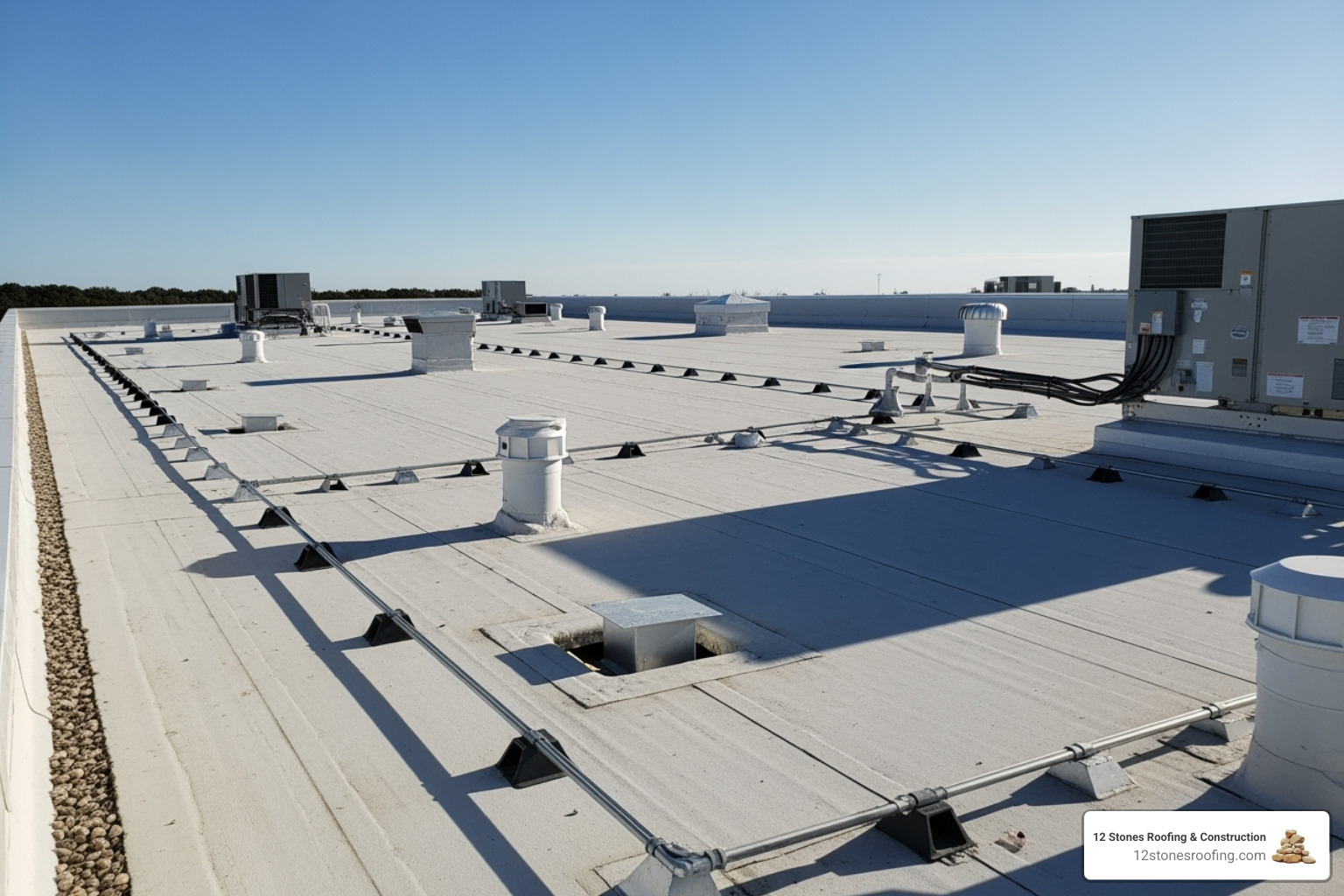
Repair or Replace? Knowing When It’s Time
Even with great maintenance, all roofs eventually reach the end of their service life. Knowing when to replace versus repair can save you money and stress. It’s time for a full new flat roof installation when you see these signs:
- The Roof’s Age: If your roof is nearing the end of its 20- to 30-year warrantied lifespan, it’s wise to plan for a replacement before it fails.
- Frequent Repairs: If you’re calling for repairs multiple times a year, it indicates a systemic failure. The cumulative cost of fixes often justifies the investment in a new roof.
- Extensive Damage: If damage like blistering or deterioration covers more than 25% of the roof surface, patching is no longer a viable solution.
A professional assessment from a licensed roofing contractor is the best way to get a clear, honest recommendation. At 12 Stones Roofing & Construction, we’ll never push a replacement if a repair is the better option—your trust is our priority.
Frequently Asked Questions about New Flat Roofs
How long does a new flat roof last?
A professionally installed new flat roof can be expected to last 20 to 30 years or more. The ultimate lifespan of materials like EPDM, TPO, and Modified Bitumen depends on three key factors: the quality of the materials used, the precision of the installation, and a consistent maintenance schedule. At 12 Stones Roofing & Construction, we build roofing systems engineered for maximum longevity by strictly adhering to manufacturer specifications.
Are flat roofs prone to leaking?
No, modern flat roofs that are installed correctly are not inherently prone to leaking. This is a common myth stemming from older, poorly installed roofs. Today’s materials and techniques, including proper slope for drainage, heat-welded seams, and expert flashing, create incredibly durable and watertight systems. When leaks do occur on modern flat roofs, the cause is almost always physical damage, deferred maintenance, or substandard installation—not a flaw in the design itself.
Can you walk on a flat roof?
Yes, most flat roofs can handle occasional foot traffic for maintenance purposes, such as inspecting drains or servicing HVAC units. However, a standard roof is not designed for regular use as a patio or deck. If you envision using your flat roof as a functional outdoor living space, it must be specifically designed for that purpose from the start. This involves installing protective systems like deck tiles, concrete pavers, or walkway pads over the primary waterproofing membrane to distribute weight and prevent damage. Before planning any rooftop activities, consult with us at (713) 358-8371 to assess your roof’s load-bearing capacity and design a safe, durable solution.
Your Partner for a Perfect Flat Roof Installation
A new flat roof installation is a complex project where quality is non-negotiable. The precision of the installation—from material selection to the final seal on every seam—directly determines your roof’s performance and lifespan. It’s about creating a comprehensive system that protects your property for decades.
At 12 Stones Roofing & Construction, we understand this is a significant investment. We approach every project with meticulous attention to detail and an unwavering commitment to quality. As a Service-Disabled Veteran-Owned firm, we bring military-grade discipline and integrity to our work. Our certifications and top 1% national ranking for quality are our promise of excellence to you.
When you choose us for your Flat Roofing services, you get more than just installers; you get a partner dedicated to protecting your property against the Texas climate. We provide transparent pricing, clear communication, and the peace of mind that comes from working with professionals who care.
Ready to invest in a durable, high-performance flat roof? Contact us today for a comprehensive, no-obligation consultation. We’ll assess your needs and provide a detailed estimate to secure your property’s future.



